Manual battery chargers are essential tools for electrolysis, offering precise control over the process. They are cost-effective, versatile, and ideal for various DIY applications like rust removal and metal restoration.
1.1 What is a Manual Battery Charger?
A manual battery charger is a device that requires user input to control voltage and current settings, crucial for electrolysis processes. Unlike automatic chargers, it allows precise adjustments, providing the necessary control and consistency for applications like rust removal and metal restoration.
1.2 The Role of Manual Chargers in Electrolysis
Manual battery chargers play a crucial role in electrolysis by providing the necessary electrical current to drive chemical reactions. They allow users to maintain consistent voltage and current levels, essential for effective rust removal and metal restoration. Unlike automatic chargers, manual chargers give precise control, preventing shutdowns during the process, which is vital for consistent electrolysis outcomes.
1.3 Why Manual Chargers are Preferred Over Automatic Ones
Manual chargers are favored for their ability to maintain steady voltage and current, crucial for electrolysis. Automatic chargers often shut down during low-battery conditions, disrupting the process. Manual chargers provide continuous power, ensuring consistent electrolysis performance without interruptions, making them ideal for rust removal and metal restoration projects.
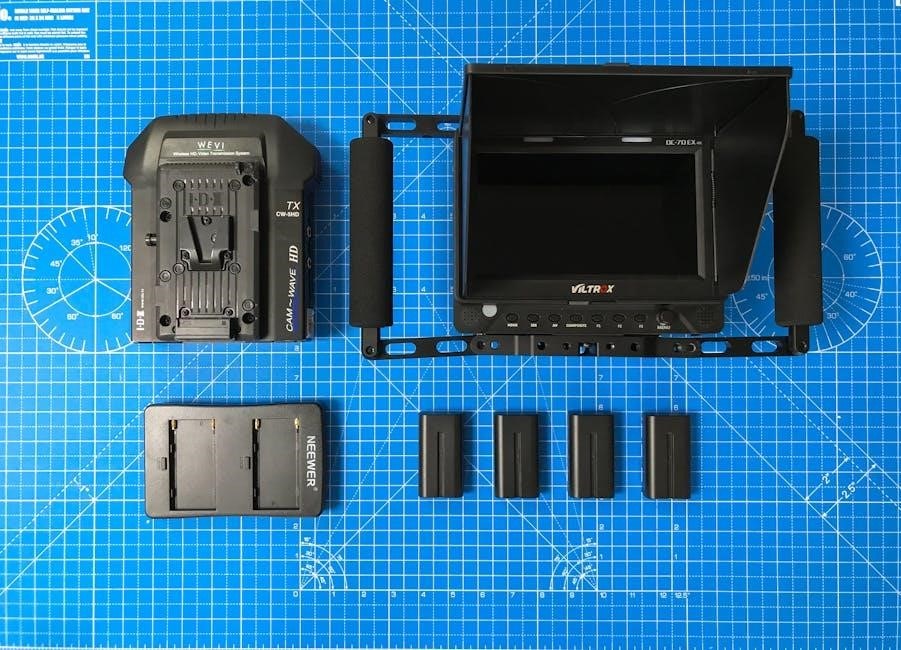
Working Principles of Manual Battery Chargers
Manual battery chargers supply steady current and voltage to drive electrolysis, ensuring consistent reactions. They rely on manual control to maintain power flow, avoiding automatic cutoffs that disrupt electrolysis processes.
2.1 Basic Science Behind Electrolysis
Electrolysis involves using an electric current to trigger chemical reactions, separating molecules or depositing metals. It requires an electrolyte solution and two electrodes connected to a power source, like a manual battery charger, to facilitate ion flow and achieve desired transformations effectively.
2.2 How Manual Chargers Supply Power for Electrolysis
Manual chargers provide a stable DC power source for electrolysis by converting AC input to DC output. They allow users to control current flow, ensuring consistent electrolysis without automatic cutoffs, making them ideal for processes requiring precise energy regulation and continuous operation.
2.3 Essential Materials Needed for the Process
Key materials include a manual battery charger, a non-reactive container, distilled water, an electrolyte solution, and sacrificial electrodes. Stainless steel or iron are common choices. Proper insulation and wiring are crucial for safety. These components ensure efficient and safe electrolysis operations.
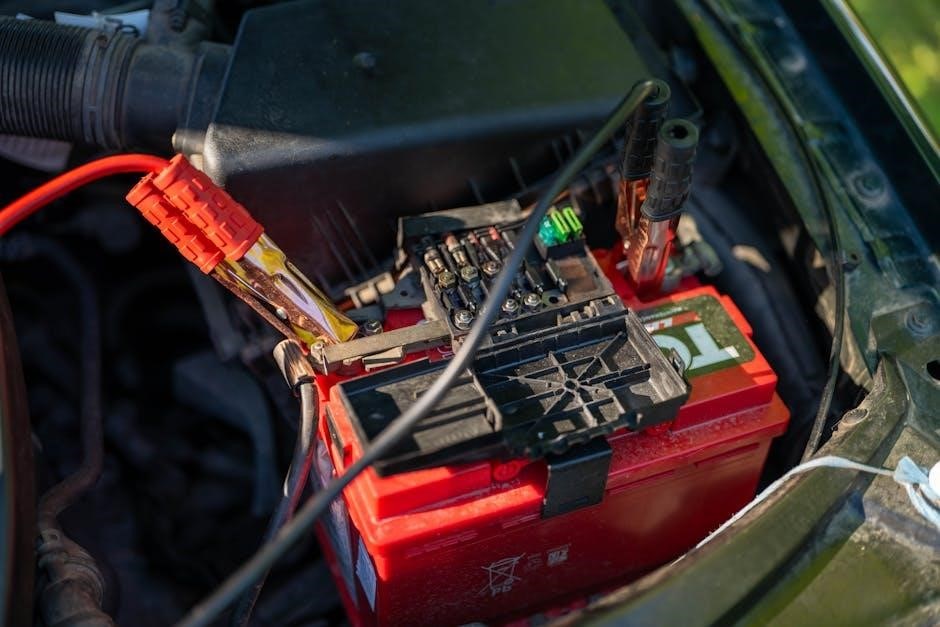
Components and Design of a Manual Battery Charger
A manual battery charger includes a power supply, voltage regulator, and control mechanisms. Its design ensures precise energy delivery, making it ideal for electrolysis applications.
3.1 Power Supply and Voltage Regulation
A manual battery charger’s power supply provides stable DC output, essential for electrolysis. Voltage regulation ensures consistent energy delivery, preventing damage to components. Adjustable settings allow customization, while safety features like overheating protection enhance reliability during extended use.
3.2 Electrodes and Their Role in Electrolysis
Electrodes are critical in electrolysis, acting as points where electrical current enters and exits the solution. Stainless steel or iron are common choices, with the positive (anode) and negative (cathode) terminals connected to the charger. Their durability and conductivity ensure efficient transfer of electrons, facilitating the chemical reaction.
3.3 Control Mechanisms for Manual Operation
Manual chargers feature adjustable knobs or switches to regulate voltage and current, allowing precise control over electrolysis. These mechanisms enable users to monitor and customize the process, ensuring optimal performance. This hands-on approach is essential for maintaining desired electrode reactions and preventing overheating or overcharging.
Advantages of Using Manual Battery Chargers
Manual chargers offer precision control, cost-effectiveness, and versatility, making them ideal for electrolysis. They provide consistent power delivery and adaptability, ensuring efficient results across various applications and projects.
4.1 Precision Control Over the Electrolysis Process
Manual chargers enable precise adjustment of current and voltage, crucial for electrolysis. This allows users to fine-tune the process, preventing overheating and ensuring even metal restoration or rust removal, making manual control indispensable for achieving desired results effectively.
4.2 Cost-Effectiveness Compared to Automatic Chargers
Manual chargers are often more affordable than automatic ones, offering significant savings without compromising efficiency. Their simplicity reduces production costs, making them a budget-friendly choice for DIY electrolysis projects, such as rust removal and metal restoration, while delivering reliable performance.
4.3 Versatility in Different Electrolysis Applications
Manual chargers are adaptable for various electrolysis tasks, such as rust removal, hydrogen production, and metal cleaning. Their adjustability makes them suitable for diverse projects, ensuring reliable performance across different applications, from small-scale DIY experiments to larger industrial processes.
Setting Up a Manual Battery Charger for Electrolysis
Connect the charger to a 12V battery, attach the positive lead to the anode and negative to the cathode, ensuring a safe and stable setup for electrolysis.
5.1 Step-by-Step Connection Guide
Connect the manual charger to a 12V battery, ensuring secure terminals. Attach the positive lead to the anode and the negative lead to the cathode. Ensure proper polarity to avoid damage. Submerge the electrodes in the electrolyte solution, maintaining safe distances to prevent short circuits. Plug in the charger and monitor the process closely.
5;2 Safety Precautions During Setup
Always wear protective gloves and eyewear. Ensure the area is well-ventilated to prevent hydrogen gas accumulation. Avoid touching electrical components with wet hands. Keep flammable materials away. Regularly inspect cables and connections for damage. Never leave the charger unattended while in operation to prevent accidents or electrical fires.
5.3 Testing the Charger Before Use
Before use, ensure the charger is functioning correctly. Check the voltage and current output with a voltmeter. Verify that the electrolysis process starts smoothly. Ensure all connections are secure and free from corrosion. Test the charger with a small-scale setup to confirm proper operation and stability of power supply.
Safety Considerations and Precautions
Ensure proper handling of electrical components to avoid shocks. Monitor temperature to prevent overheating. Use protective gear when dealing with corrosive electrolytes and follow ventilation guidelines for safe operation.
6.1 Risks of Electrical Shock and Overheating
Manual battery chargers pose risks of electrical shock if improperly connected. Overheating can occur during prolonged use, damaging components. Ensure proper insulation and monitor temperature. Always use protective gear to mitigate these hazards and maintain a safe operating environment.
6.2 Handling Corrosive Electrolytes Safely
Handling corrosive electrolytes in manual battery charger electrolysis requires caution. Always wear protective gloves and goggles to prevent skin and eye contact. Ensure adequate ventilation to avoid inhaling fumes. Store electrolytes in tightly sealed containers and dispose of them safely, adhering to environmental regulations to prevent contamination.
6.3 Environmental and Disposal Precautions
Proper disposal of electrolytes and batteries is crucial for environmental safety. Use sealed containers to store waste and adhere to local regulations to prevent contamination. Neutralize electrolytes before disposal and recycle batteries responsibly to minimize ecological impact. Always follow eco-friendly practices to protect the environment.

Applications of Manual Battery Chargers in Electrolysis
Manual battery chargers are widely used for rust removal, hydrogen production, and cleaning metals. They enable efficient electrolysis processes, making them ideal for restoration projects and DIY applications.
7.1 Rust Removal and Metal Restoration
Manual battery chargers are effective for rust removal and metal restoration through electrolysis. By attaching the charger’s terminals to the metal, rust is efficiently dissolved, preserving the material’s integrity. This method is versatile and works on various metals, making it a popular choice for restoration projects and DIY enthusiasts.
7.2 Hydrogen Production Through Water Electrolysis
Manual battery chargers facilitate hydrogen production by applying an electric current to water, splitting it into hydrogen and oxygen gases. This process is efficient and sustainable, utilizing minimal equipment for clean energy generation, making it a promising method for eco-friendly applications and renewable energy projects.
7.3 Cleaning Cast Iron and Other Metals
Manual battery chargers are widely used for cleaning cast iron and other metals through electrolysis. By applying an electric current, rust and corrosion are effectively removed, restoring metal surfaces. This method is efficient, cost-effective, and ideal for DIY restoration projects, making it a popular choice for metal enthusiasts and restorers.
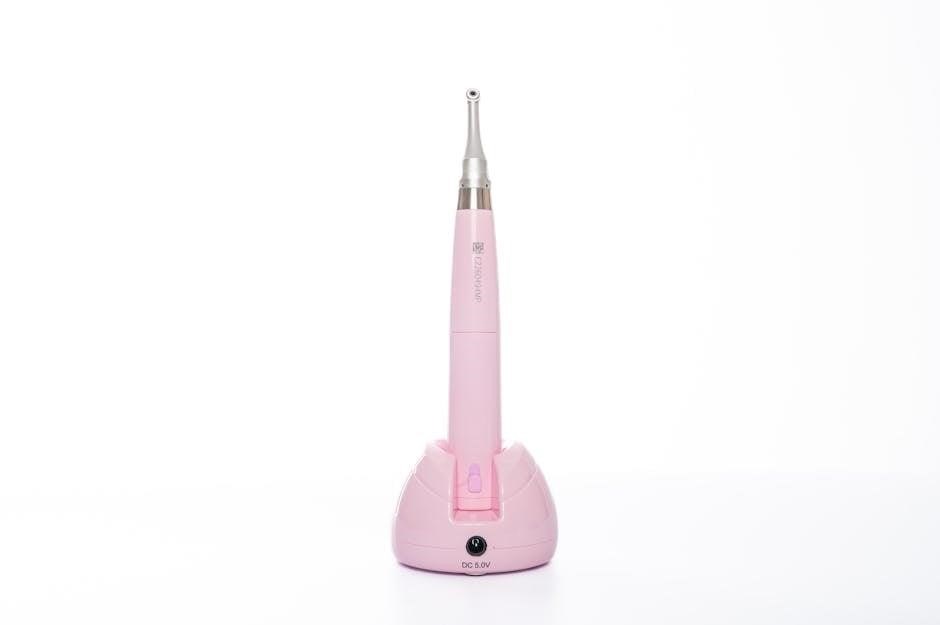
DIY Modifications for Enhanced Functionality
DIY enthusiasts can modify manual battery chargers to improve performance in electrolysis. Converting automatic chargers to manual operation or building custom systems enhances versatility and efficiency for specific tasks.
8.1 Converting an Automatic Charger to Manual
Converting an automatic charger to manual enables precise control over electrolysis processes. This modification is ideal for DIY projects, allowing users to bypass automatic shutdowns and maintain steady current flow, essential for efficient rust removal and metal restoration tasks.
8.2 Building a Custom Electrolysis System
Building a custom electrolysis system offers versatility for specific applications. Use a 12V battery charger, water, and a sacrificial metal like stainless steel; This setup allows precise control over the process, making it ideal for rust removal and metal restoration. Customization enables tailored solutions for various project sizes and requirements.
8.3 Upgrading Charger Capacity for Larger Projects
Upgrading a manual battery charger’s capacity enhances its suitability for larger electrolysis projects. Consider a 12V charger with adjustable current settings to handle bigger tasks. Models like the Schumacher SE-82-6 offer flexibility, supporting higher amp requirements. This upgrade ensures efficient operation for extensive rust removal or multiple metal pieces simultaneously, improving overall productivity.
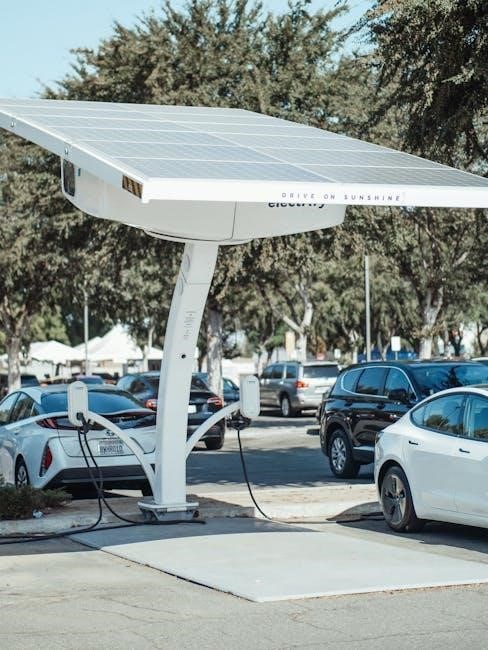
Best Practices for Using Manual Battery Chargers
For optimal results, use the correct electrolyte, monitor voltage, and maintain electrodes. Regularly inspect cables and connections to ensure safety and efficiency during electrolysis processes.
9.1 Choosing the Right Electrolyte Solution
Selecting the appropriate electrolyte is crucial for effective electrolysis. Use distilled or pure water with added electrolytes like baking soda or vinegar. Avoid corrosive solutions and ensure compatibility with your electrodes to optimize performance and safety during the process;
9.2 Maintaining the Charger and Electrodes
Regular maintenance ensures longevity and efficiency. Clean electrodes to prevent corrosion and inspect for wear. Check the charger’s terminals and wiring for damage. Store components in a dry, cool place and replace worn parts promptly to maintain optimal performance during electrolysis processes.
9.3 Monitoring the Electrolysis Process
Constant monitoring ensures safe and effective electrolysis. Check voltage and current regularly to avoid overloading the charger. Observe electrode condition and electrolyte levels, replacing solutions as needed. Ensure proper connections to prevent overheating or electrical hazards, maintaining optimal performance throughout the process.
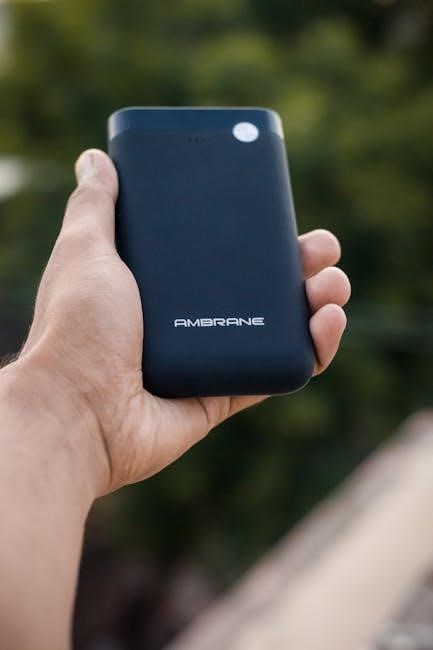
Troubleshooting Common Issues
Common issues include low current output, faulty connections, or overheating. Check cables, ensure proper voltage, and verify electrolyte levels. Addressing these promptly prevents process failure and ensures safety.
10.1 Diagnosing Faulty Charger Performance
Check for faulty charger performance by monitoring voltage and current output. Ensure all connections are secure and free from corrosion. Verify the charger’s manual settings and test with a multimeter to identify issues like internal circuit malfunctions or power supply problems.
10.2 Resolving Electrode Corrosion Problems
Address electrode corrosion by using a sacrificial metal anode and ensuring proper electrolyte composition. Regularly clean and inspect electrodes, and adjust charger settings to avoid excessive current flow. Using distilled water and maintaining correct voltage can help minimize corrosion and extend electrode lifespan.
10.3 Fixing Common Electrical Malfunctions
Common electrical issues can often be resolved by checking power supplies, ensuring proper connections, and inspecting for component failures. Replace blown fuses, clean corroded terminals, and ensure the charger is set to the correct voltage. Addressing overheating by improving ventilation and verifying compatibility with your electrolysis setup can prevent further malfunctions.
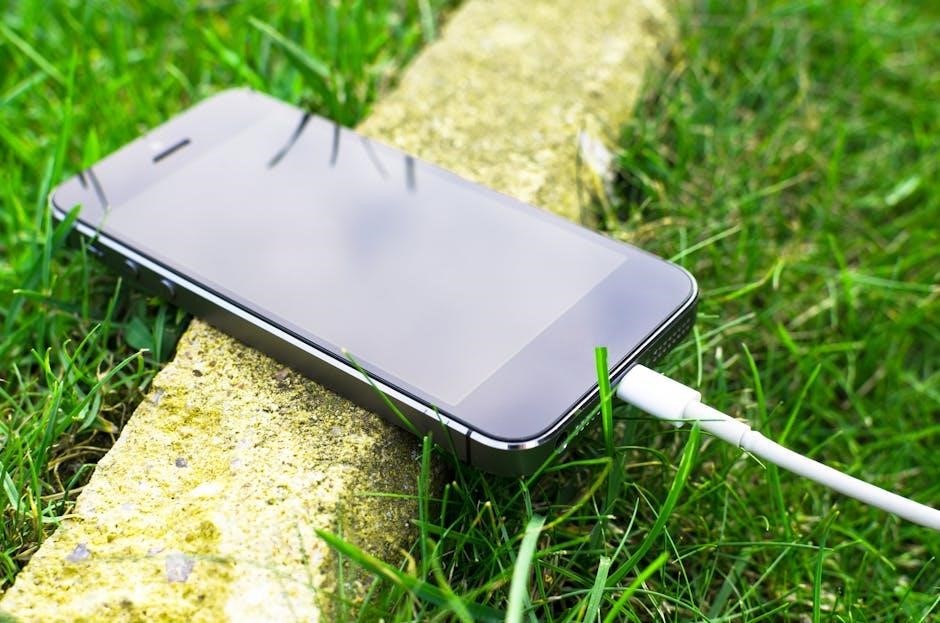
Future Trends and Innovations
Future trends include integrating manual chargers with renewable energy sources and advancing eco-friendly designs, enhancing their role in sustainable electrolysis processes and green energy applications.
11.1 Advances in Manual Charger Technology
Advances in manual charger technology focus on efficiency, safety, and eco-friendly designs, integrating renewable energy sources and smart control systems.
These innovations enhance performance in electrolysis applications, support sustainable practices, and ensure manual chargers remain vital in green energy initiatives while maintaining cost-effectiveness.
11.2 Integration with Renewable Energy Sources
Manual battery chargers are increasingly being paired with solar panels and wind turbines, enabling sustainable energy storage and use in electrolysis. This integration reduces reliance on grid power, lowers carbon footprints, and enhances energy efficiency, making manual chargers more eco-friendly and viable for green energy applications.
11.3 Potential Applications in Green Energy
Manual battery chargers show promise in green energy by enabling efficient energy storage for renewable power sources. They can facilitate hydrogen production via water electrolysis, support solar-powered electrolysis systems, and aid in small-scale, eco-friendly metal restoration projects, contributing to sustainable and energy-efficient solutions for a low-carbon future.
Manual battery chargers offer a cost-effective, versatile solution for electrolysis, providing precise control and efficiency. Ideal for DIY projects, they empower users to achieve professional-grade results effortlessly.
12.1 Summary of Key Benefits
Manual battery chargers for electrolysis provide precise control, cost-effectiveness, and versatility, making them ideal for rust removal, hydrogen production, and metal cleaning; Their simplicity and adaptability ensure efficient, reliable results, catering to both small-scale DIY projects and larger applications with ease and consistency.
12.2 Encouragement for DIY Enthusiasts
DIY enthusiasts will find manual battery chargers ideal for electrolysis projects, offering ease of setup and versatility. With minimal investment, you can achieve professional results, making it perfect for rust removal, metal restoration, and other creative applications. Embrace the satisfaction of DIY electrolysis with cost-effective, hands-on solutions.
12.3 Final Thoughts on Manual Chargers for Electrolysis
Manual battery chargers are a reliable and cost-effective solution for electrolysis projects. Their simplicity and precision make them ideal for small-scale applications, offering users control and efficiency. Whether for rust removal or hydrogen production, these chargers prove invaluable, delivering consistent results with minimal investment in equipment.
